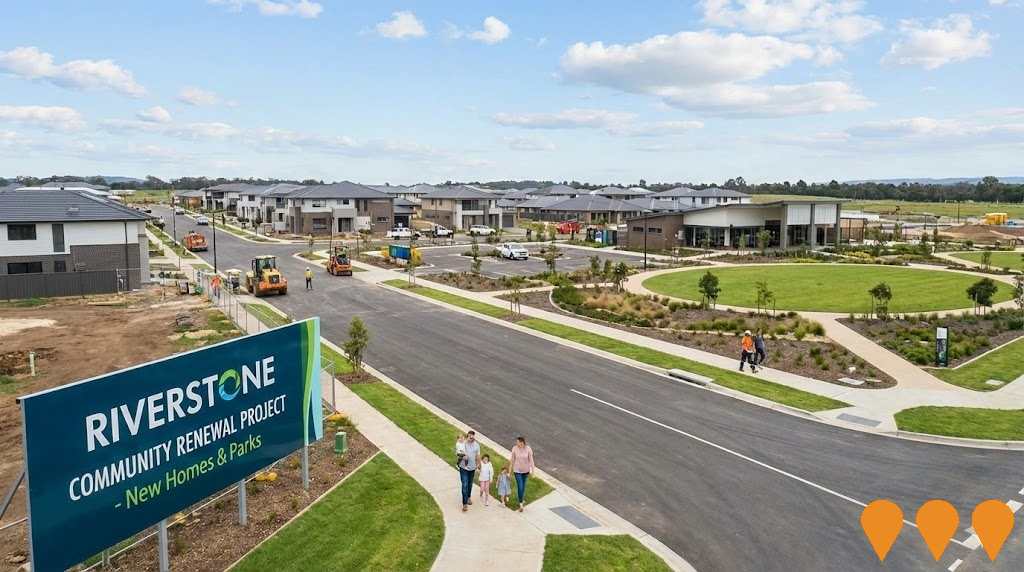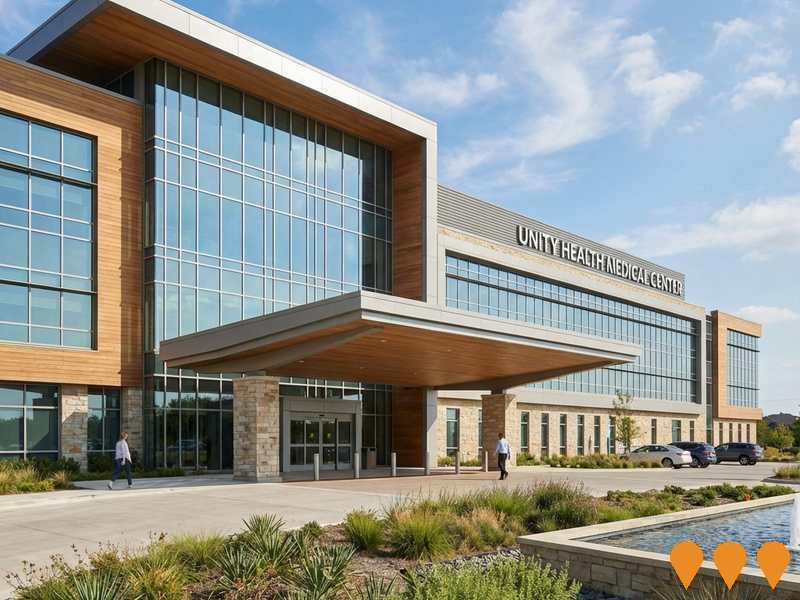Chart Color Schemes
est. as @ -- *
ABS ERP | -- people | --
2021 Census | -- people
Sales Activity
Curious about local property values? Filter the chart to assess the volume and appreciation (including resales) trends and regional comparisons, or scroll to the map below view this information at an individual property level.
Find a Recent Sale
Sales Detail
Population
Chullora lies within the top quartile of areas nationally for population growth performance according to AreaSearch analysis of recent, and medium to long-term trends
Chullora's population, as of August 2025, is approximately 1,503 people. This figure represents an increase of 34 individuals, a rise of 2.3% since the 2021 Census which recorded a total of 1,469 residents. The growth was inferred from ABS's estimated resident population of 1,506 in June 2024 and two additional validated addresses post-Census. This results in a population density of 371 persons per square kilometer. Over the past decade, Chullora has shown consistent growth with a compound annual growth rate of 25.1%, surpassing its SA3 area's average. Overseas migration contributed roughly 53.3% to recent population gains.
AreaSearch uses ABS/Geoscience Australia projections for each SA2 area released in 2024, based on 2022 data. For areas not covered by this data, NSW State Government's SA2 level projections from 2022 using 2021 base year are applied. Growth rates by age group are projected until 2041. By 2041, Chullora is expected to increase by approximately 99 persons, reflecting a total growth of about 6.8% over the 17-year period.
Frequently Asked Questions - Population
Development
Residential development activity is lower than average in Chullora according to AreaSearch's national comparison of local real estate markets
Chullora has seen virtually no dwelling approvals in recent years, totalling 2 homes over the past five financial years. As of FY-26 so far, 0 approvals have been recorded. Over the past five financial years, between FY-21 and FY-25, an average of 73 new residents arrived per year for each dwelling constructed, indicating substantial supply lagging behind demand. This typically results in heightened buyer competition and pricing pressures.
New homes are being built at an average expected construction cost value of $120,000, which is under regional levels, suggesting more accessible housing choices for buyers. In this financial year, $53.0 million in commercial development approvals have been recorded, reflecting robust local business investment. Compared to Greater Sydney, Chullora shows substantially reduced construction activity. This constrained new construction usually reinforces demand and pricing for existing dwellings, though development activity has picked up in recent periods. The current level of dwelling construction is similarly under the national average, indicating the area's established nature and suggesting potential planning limitations.
Frequently Asked Questions - Development
Infrastructure
Chullora has very high levels of nearby infrastructure activity, ranking in the top 20% nationally
Eight projects have been identified by AreaSearch as potentially impacting the area's performance. These include: T6 Lidcombe & Bankstown Line Service, Bankstown City Centre DCP 2024, Salt Pan Creek Channel Repairs, and Henry Lawson Drive Upgrade Program. The following list details those likely to be most relevant.
Professional plan users can use the search below to filter and access additional projects.
INFRASTRUCTURE SEARCH
 Denotes AI-based impression for illustrative purposes only, not to be taken as definitive under any circumstances. Please follow links and conduct other investigations from the project's source for actual imagery. Developers and project owners wishing us to use original imagery please Contact Us and we will do so.
Denotes AI-based impression for illustrative purposes only, not to be taken as definitive under any circumstances. Please follow links and conduct other investigations from the project's source for actual imagery. Developers and project owners wishing us to use original imagery please Contact Us and we will do so.
Frequently Asked Questions - Infrastructure
Bankstown TOD Accelerated Precinct
State-led Transport Oriented Development (TOD) Accelerated Precinct around Bankstown station and CBD. Rezoning effective 27 November 2024 delivering capacity for 14,000 new homes (including 3-4% affordable housing) and 14,300 new jobs across a large mixed-use precinct. Features buildings ranging from 1 to 25 storeys around the new Metro station. Includes new parks, improved transport connectivity, walkways and cycleways. Part of the NSW Government's TOD Program to boost housing supply near major transport hubs. The NSW Government has committed $520 million to provide active transport links and quality public open spaces across TOD Accelerated Precincts. Potential upgrades proposed for Memorial Park and Griffith Park. Development expected over the next 10-15 years.
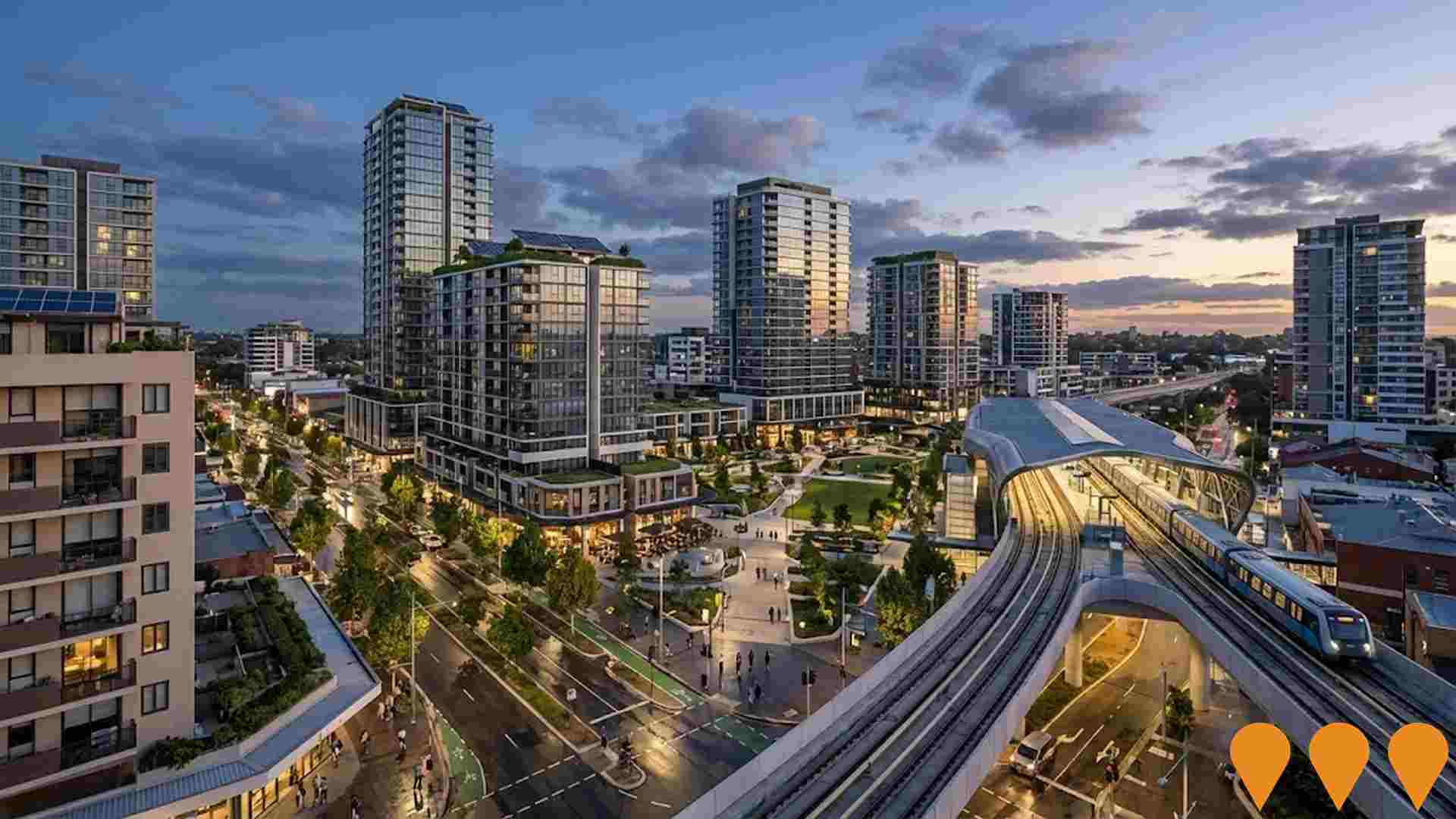
New Bankstown Hospital
The NSW Government is delivering a brand-new $2 billion+ state-of-the-art hospital on the Bankstown TAFE campus site in the Bankstown CBD. This is the largest single investment in a public hospital in NSW history. The new multi-storey facility will deliver expanded emergency, intensive care, operating theatres, maternity, paediatrics, mental health, cancer care, aged care and comprehensive teaching/training facilities. The existing Bankstown-Lidcombe Hospital will transition acute services to the new site upon completion (expected 2031) and be repurposed for community health services. As of December 2025 the project remains in detailed planning with the State Significant Development Application (SSD-46059944) under assessment by the Department of Planning, Housing and Infrastructure. Community consultation continues and early works (site preparation and demolition) are scheduled to commence in 2026 subject to final approvals.
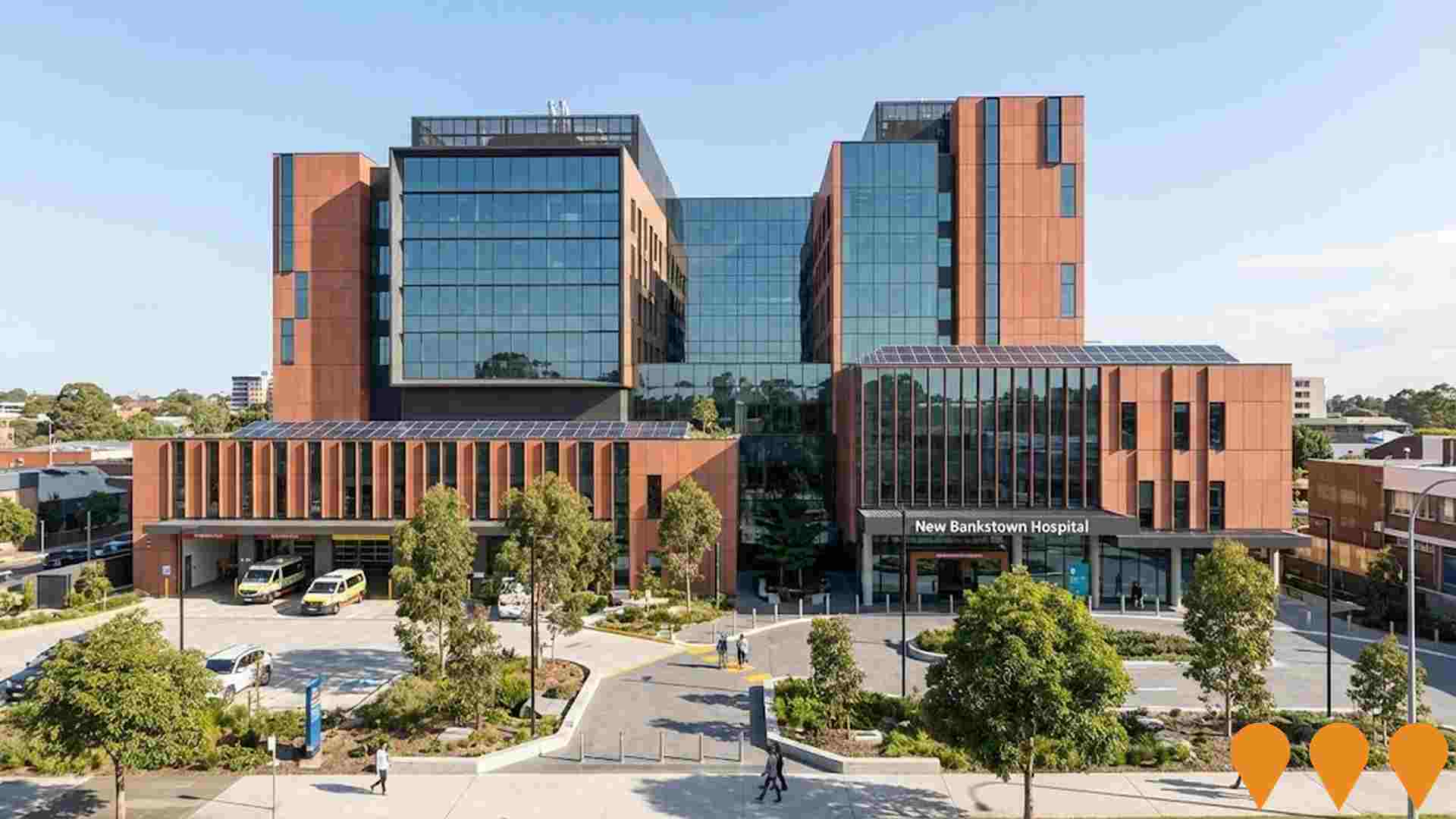
Sydney Metro Bankstown Line Conversion
Conversion of the T3 Bankstown Line between Sydenham and Bankstown to metro standards as part of the Sydney Metro City & Southwest project. Includes upgrades to 11 stations with platform screen doors, new signalling systems, accessibility enhancements (lifts and level access), track modifications, and introduction of autonomous, air-conditioned metro trains with 4-minute peak frequencies. The line closed in September 2024 for intensive conversion works managed by Martinus Rail. Expected to open in 2026 (delayed from earlier targets due to industrial action). Provides fast travel times, e.g., Bankstown to Central in 28 minutes, and forms part of the overall 66 km Sydney Metro network.
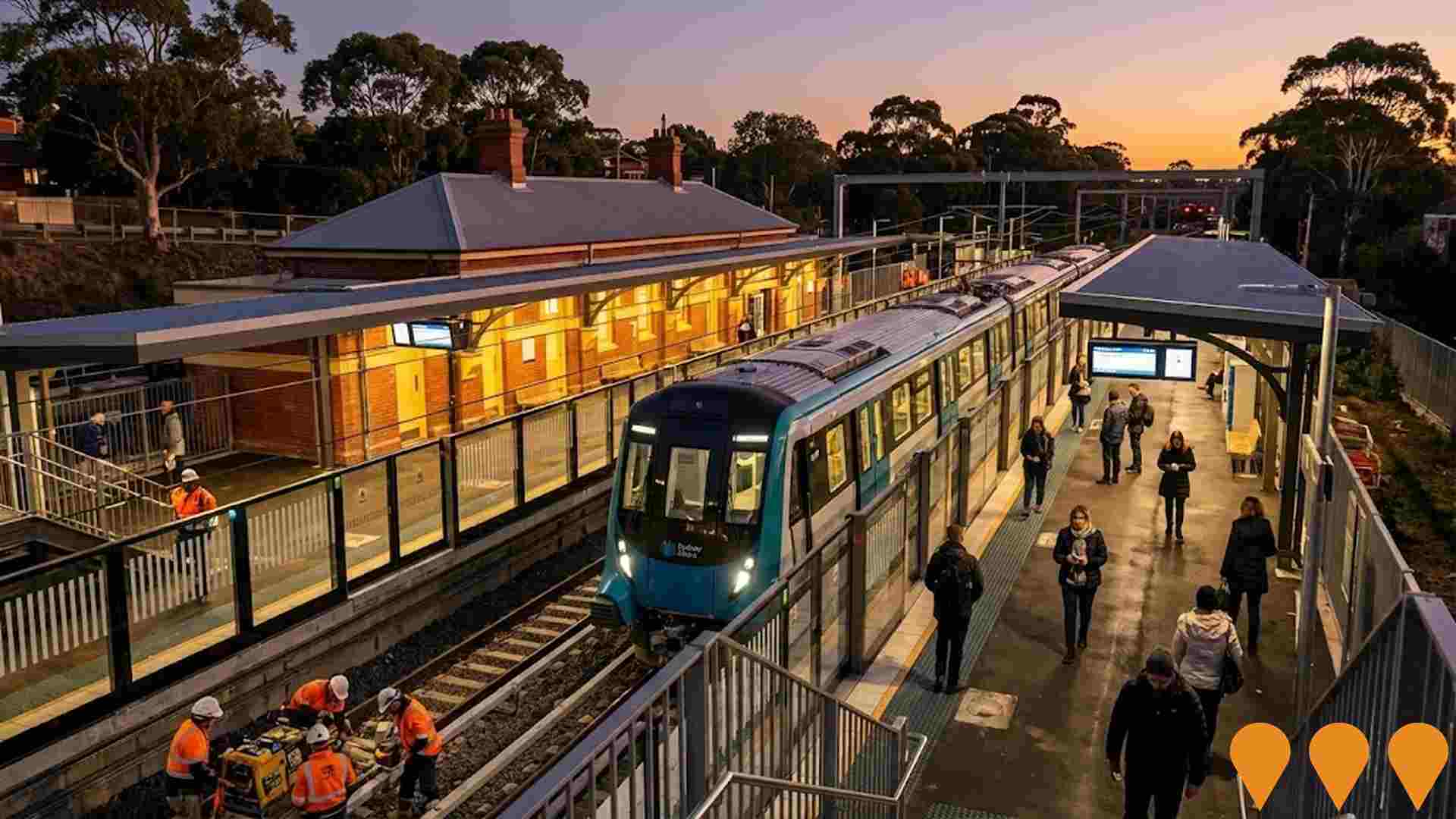
Community Infrastructure Strategic Plan 2050
Canterbury-Bankstown Council's adopted long-term framework (2023-2050) guiding the planning, funding and delivery of community infrastructure including libraries, community centres, aquatic and leisure facilities, sports fields, parks, cultural spaces and civic facilities to support a growing and changing population across the entire LGA.

Bankstown Central Masterplan
A 30-year transformational redevelopment of 11.4 hectares in Bankstown CBD into a vibrant mixed-use urban neighbourhood. Stage One, Bankstown Exchange, features 30,000 sqm of A-grade commercial office space across three buildings with ground-floor retail and an Eat Street dining precinct. The full masterplan includes up to 3,500 residential apartments, 1,800 student accommodation units, 800-guest hotel, serviced apartments, childcare facilities, and landscaped green spaces. The project aims to create a Health and Education Innovation Precinct, supporting 8,400 workers and generating significant economic activity. Retail precinct upgrades include The Grand Market fresh food area with new Coles supermarket, plus major retailers like Uniqlo, JB Hi-Fi, and Services Australia. The development integrates with the Sydney Metro City & Southwest line and complements the adjacent Western Sydney University campus.
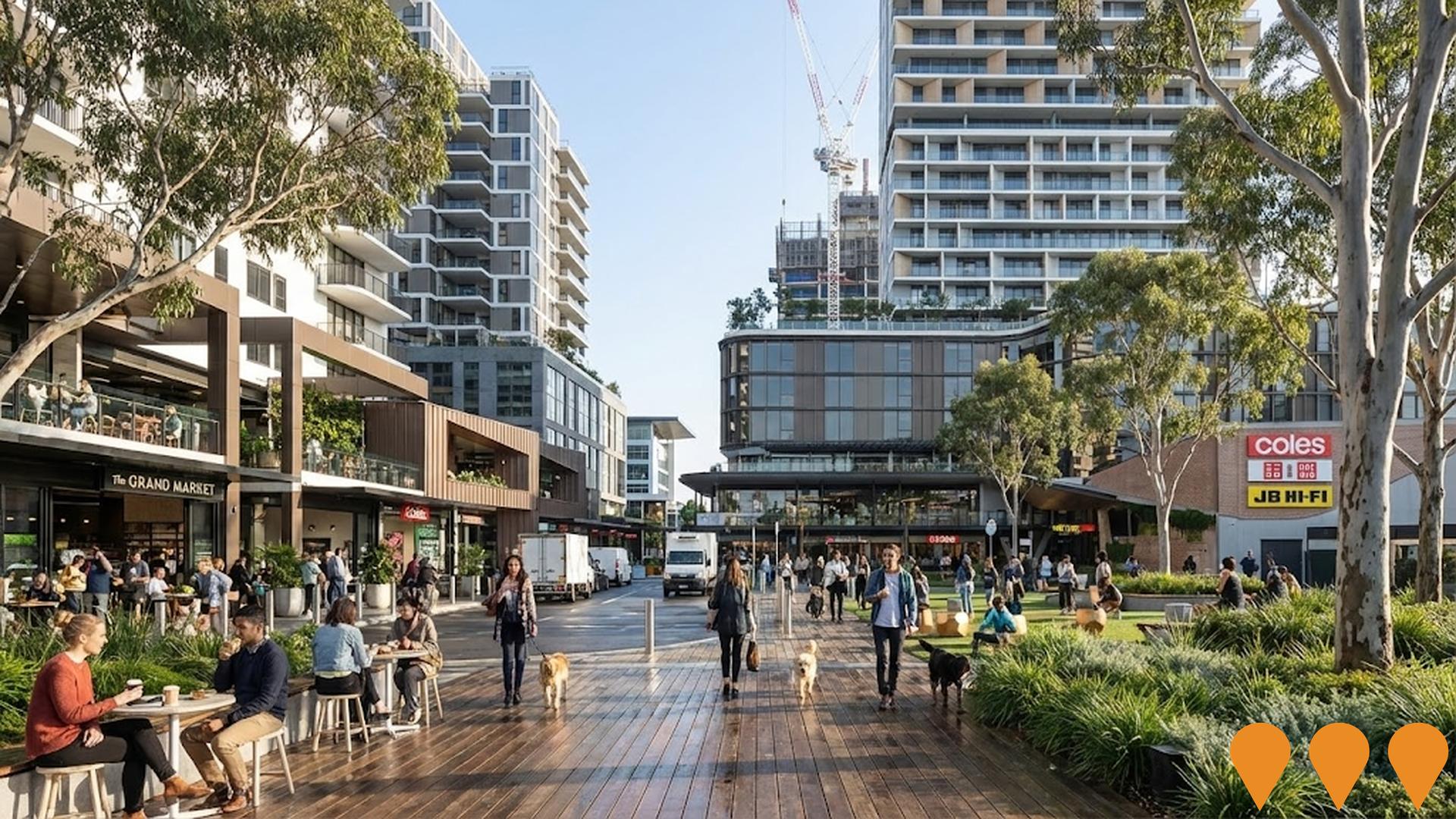
Compass Centre Redevelopment
Redevelopment of the Compass Centre site in Bankstown with demolition of existing structures and construction of a mixed-use precinct featuring a 5-storey podium and three towers: one 19-storey hotel (~169 rooms) and two 24-storey residential build-to-rent towers (339 apartments). Includes retail spaces, supermarket, gym, childcare centre, medical centre, function centre, through-site links to Bankstown Station and Paul Keating Park, enhanced public domain, landscaping, and a two-level basement. SSD application (PPSSDH-182) under assessment as of November 2025.
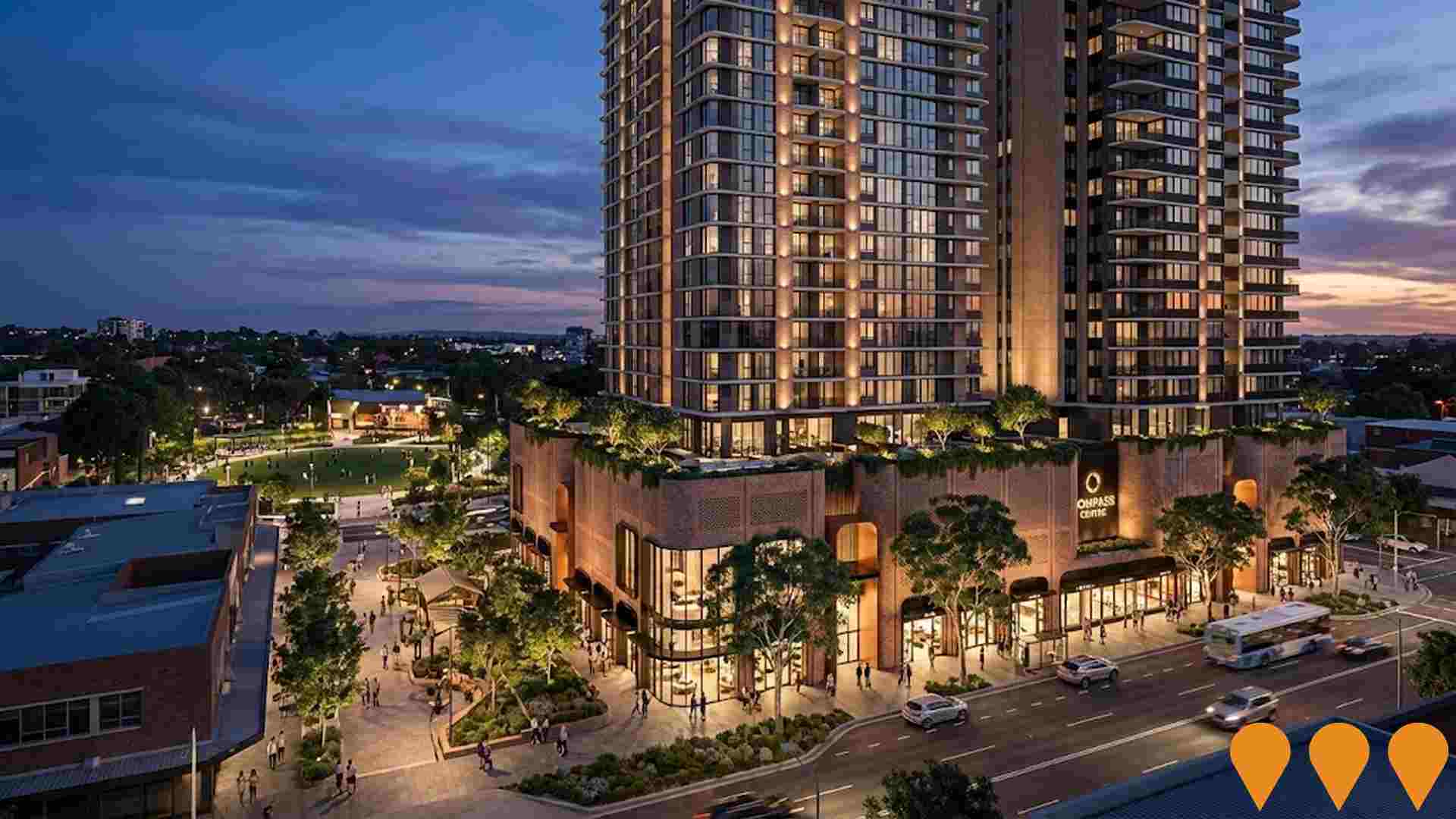
Salt Pan Creek Channel Repairs
Structural repairs and bank stabilization along Salt Pan Creek within the Cooks River catchment, affecting parts of Greenacre, Punchbowl, Belfield and nearby suburbs. Scope includes flood mitigation, stormwater channel rehabilitation, erosion control and environmental restoration works to improve waterway health and reduce flood risk.
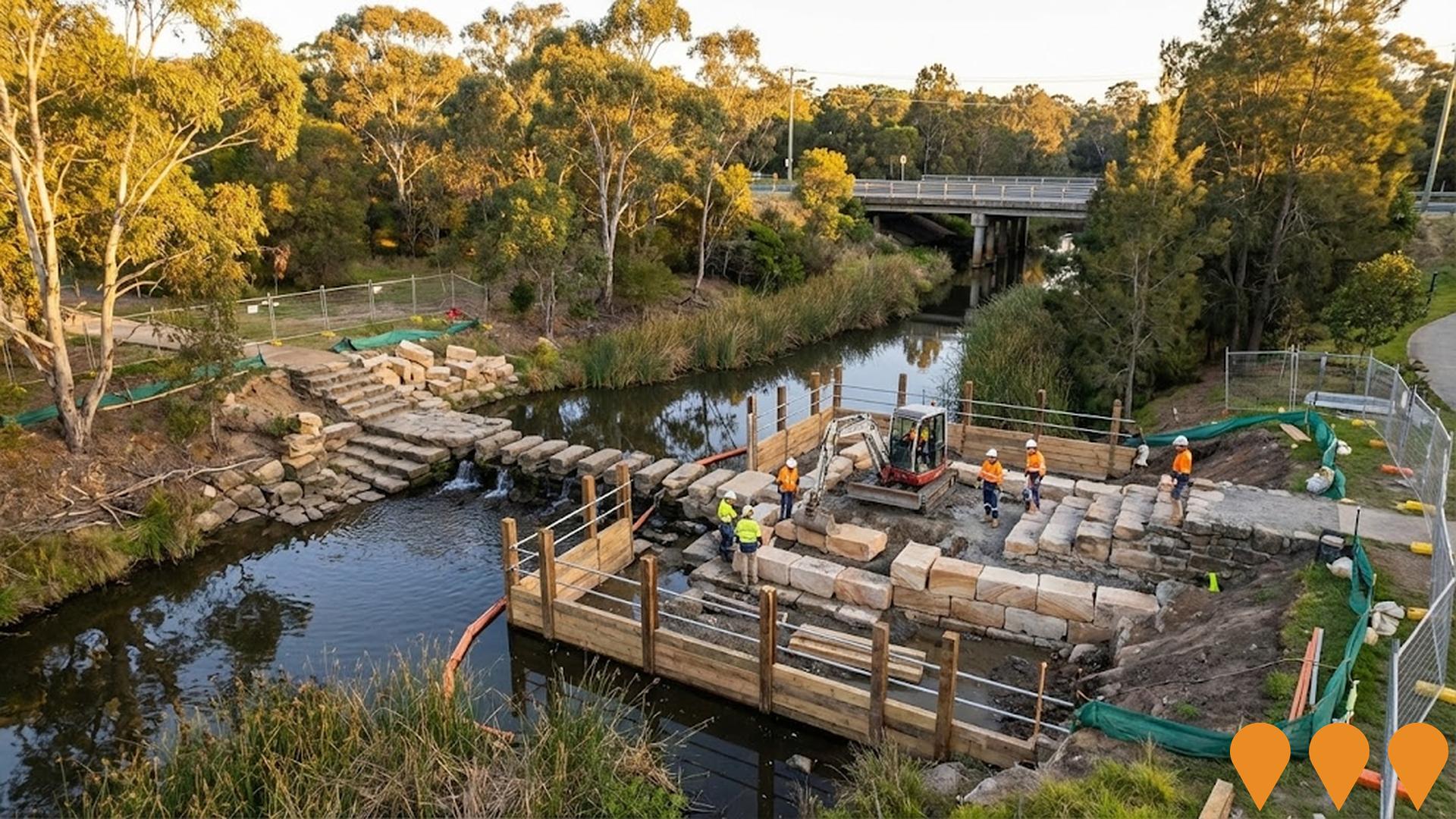
T6 Lidcombe & Bankstown Line Service
The T6 Lidcombe & Bankstown Line is a train service operating between Lidcombe and Bankstown, maintaining connectivity for communities during the Sydney Metro City & Southwest conversion of the T3 Bankstown Line. It provides direct connections and vital transport links along the corridor.
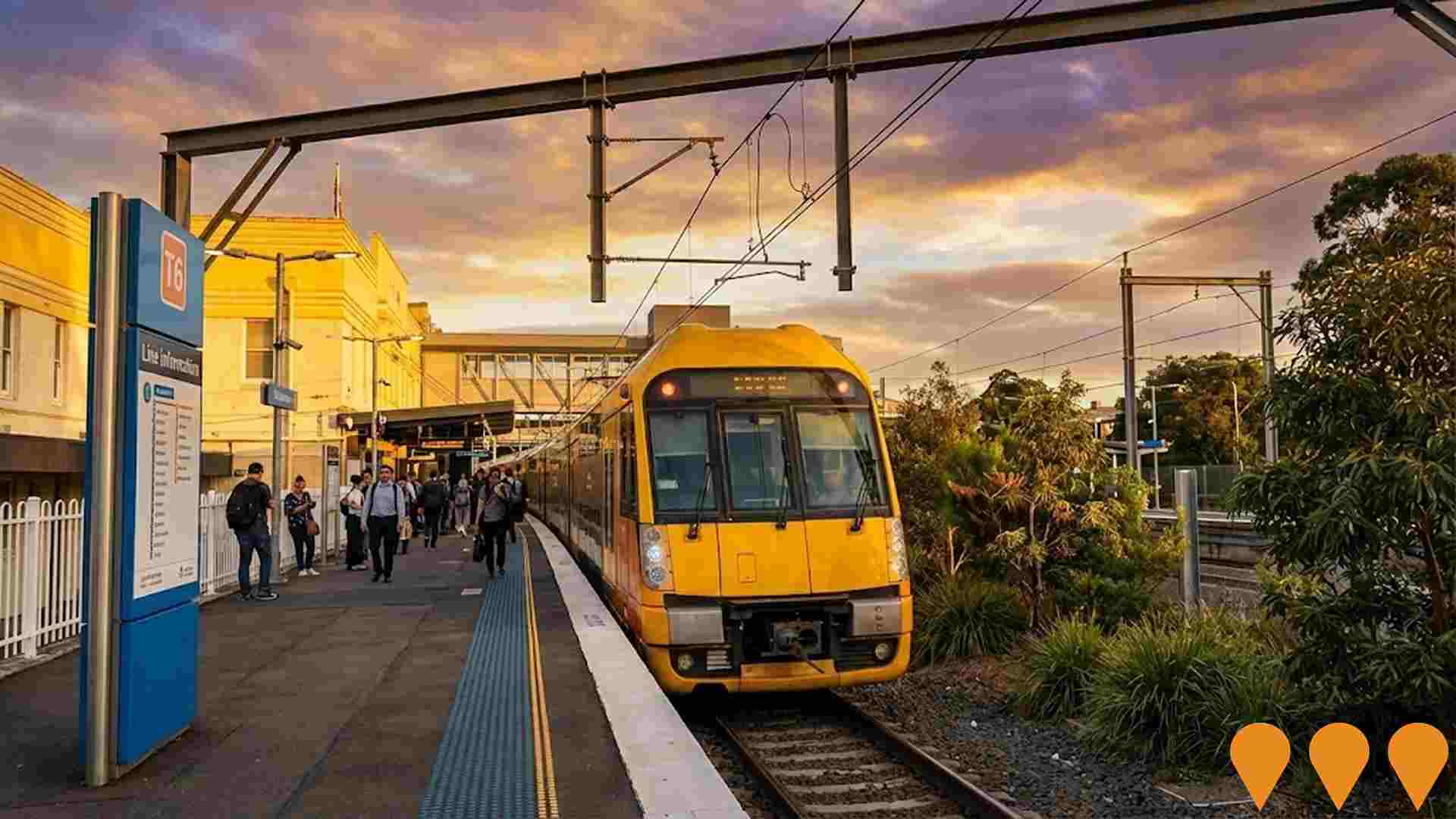
Employment
The labour market in Chullora demonstrates typical performance when compared to similar areas across Australia
Chullora has a highly educated workforce with professional services showing strong representation. The unemployment rate was 3.6% as of June 2025.
Employment growth over the past year was estimated at 2.8%. As of June 2025904 residents were in work while the unemployment rate was 0.6% below Greater Sydney's rate of 4.2%, and workforce participation was broadly similar to Greater Sydney's 60.0%. The dominant employment sectors among residents include health care & social assistance, professional & technical services, and finance & insurance.
Retail trade had limited presence with 7.3% employment compared to 9.3% regionally. There were 6.8 workers for every resident as at the Census, indicating Chullora functions as an employment hub hosting more jobs than residents and attracting workers from surrounding areas. During the year to June 2025, employment levels increased by 2.8% and labour force increased by 2.5%, causing the unemployment rate to fall by 0.3 percentage points. By comparison, Greater Sydney recorded employment growth of 2.6%, labour force growth of 2.9%, with unemployment rising 0.3 percentage points. Jobs and Skills Australia's national employment forecasts from May 2025 project national employment expansion at 6.6% over five years and 13.7% over ten years, with varying growth rates between industry sectors. Applying these projections to Chullora's employment mix suggests local growth of approximately 7.0% over five years and 14.3% over ten years.
Frequently Asked Questions - Employment
Income
Income levels align closely with national averages, indicating typical economic conditions for Australian communities according to AreaSearch analysis
AreaSearch's data for financial year 2022 shows median income in Chullora at $43,125 and average income at $54,874. This is below Greater Sydney's median income of $56,994 and average income of $80,856. As of September 2025, estimated incomes are approximately $48,563 (median) and $61,794 (average), based on a 12.61% Wage Price Index growth since financial year 2022. Census 2021 data indicates that incomes in Chullora cluster around the 72nd percentile nationally. The predominant income cohort spans 31.7% of locals, earning between $1,500 and $2,999 weekly. A significant 35.9% earn above $3,000 weekly. High housing costs consume 22.3% of income, but strong earnings place disposable income at the 69th percentile nationally. The area's SEIFA income ranking places it in the 8th decile.
Frequently Asked Questions - Income
Housing
Chullora features a more urban dwelling mix with significant apartment living, with a higher proportion of rental properties than the broader region
Dwelling structure in Chullora, as evaluated at the Census conducted in 2016, comprised 45.6% houses and 54.3% other dwellings (semi-detached, apartments, 'other' dwellings). This compares to Sydney metropolitan area's 61.5% houses and 38.4% other dwellings. Home ownership in Chullora was at 10.6%, with the remainder of dwellings either mortgaged (47.8%) or rented (41.5%). The median monthly mortgage repayment in the area was $2,600, while the median weekly rent figure was recorded at $500. Nationally, Chullora's mortgage repayments are significantly higher than the Australian average of $1,863, while rents are substantially above the national figure of $375.
Frequently Asked Questions - Housing
Household Composition
Chullora features high concentrations of family households, with a higher-than-average median household size
Family households account for 83.4% of all households, including 47.4% couples with children, 21.8% couples without children, and 11.5% single parent families. Non-family households constitute the remaining 16.6%, with lone person households at 14.6% and group households comprising 2.9% of the total. The median household size is 3.2 people, which is larger than the Greater Sydney average of 3.1.
Frequently Asked Questions - Households
Local Schools & Education
The educational profile of Chullora exceeds national averages, with above-average qualification levels and academic performance metrics
Chullora's residents aged 15+ have a notably higher university qualification rate of 45.9%, surpassing the SA3 area average of 26.3% and Australia's national average of 30.4%. The area's educational advantage is evident in its Bachelor degree holders (32.7%), postgraduate qualifications (11.2%), and graduate diplomas (2.0%). Vocational pathways account for 22.9%, with advanced diplomas at 10.7% and certificates at 12.2%. Educational participation is high, with 35.4% of residents currently enrolled in formal education: 11.8% in primary, 8.4% in secondary, and 7.8% pursuing tertiary education.
Educational facilities seem to be located outside Chullora's immediate boundaries, requiring families to access schools in neighboring areas.
Frequently Asked Questions - Education
Schools Detail
Nearby Services & Amenities
Transport
Transport servicing is high compared to other areas nationally based on assessment of service frequency, route connectivity and accessibility
Transport analysis shows 22 active stops in Chullora, served by buses. These stops are covered by 8 routes offering a total of 2032 weekly passenger trips. Residential access to transport is rated good, with residents typically located 212 metres from the nearest stop.
Service frequency averages 290 trips daily across all routes, equating to approximately 92 weekly trips per individual stop.
Frequently Asked Questions - Transport
Transport Stops Detail
Health
Chullora's residents boast exceedingly positive health performance metrics with very low prevalence of common health conditions across all age groups
Chullora's health outcomes show notable results with a very low prevalence of common health conditions across all age groups. The rate of private health cover is approximately 47%, covering about 709 people, which is lower than the national average of 55.3%.
The most prevalent medical conditions in the area are asthma and diabetes, affecting 4.9% and 3.7% of residents respectively. A total of 85.2% of residents report being completely clear of medical ailments, higher than the Greater Sydney average of 75.8%. In Chullora, 11.9% of residents are aged 65 and over (178 people), lower than the 15.8% in Greater Sydney. Despite this, health outcomes among seniors require more attention compared to the broader population.
Frequently Asked Questions - Health
Cultural Diversity
Chullora is among the most culturally diverse areas in the country based on AreaSearch assessment of a range of language and cultural background related metrics
Chullora has a population where 51.9% were born overseas, with 70.4% speaking languages other than English at home. The predominant religion is Islam, practiced by 38.4%, compared to the Greater Sydney average of 27.9%. In terms of ancestry, 'Other' represents 28.5%, higher than the regional average of 20.1%.
Chinese ancestry comprises 15.6% and Vietnamese 9.9%, both higher than their respective regional averages of 7.6% and 3.4%. Notably, Korean (6.9%) and Lebanese (8.8%) are overrepresented compared to regional figures of 0.7% and 14.9%. Macedonian ancestry is present at 1.3%, slightly lower than the regional average of 1.7%.
Frequently Asked Questions - Diversity
Age
Chullora hosts a very young demographic, ranking in the bottom 10% of areas nationwide
Chullora's median age is 32 years, which is younger than the Greater Sydney average of 37 years and significantly lower than the national average of 38 years. Compared to Greater Sydney, Chullora has a higher percentage of residents aged 25-34 (18.7%) but fewer residents aged 75-84 (2.9%). Post-2021 Census data indicates demographic aging with the median age increasing from 31 to 32 years. Key changes include the growth of the 55-64 age group from 7.9% to 10.8%, and the increase of the 85+ cohort from 0.0% to 1.7%. Conversely, the 0-4 cohort declined from 9.7% to 6.1%, and the 5-14 age group decreased from 13.6% to 11.7%. By 2041, demographic modeling suggests significant changes in Chullora's age profile. The 85+ cohort is projected to grow by 545%, adding 136 residents to reach 161. Residents aged 65 and older will represent 78% of anticipated growth, while both the 45-54 and 15-24 age groups are expected to decrease in number.



